
The 'Great' 1911 Air Race visits Whipton
Back to historic events in Exeter
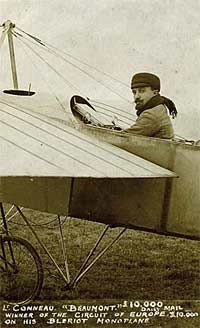
The winner Beaumont after he
won the Circuit of Europe race, weeks
before. A strip map is in front of Beaumont.
Edwardian Exonians were familiar with balloons drifting over the city, as several plucky aeronauts had demonstrated their skills through the nineteenth century. The Flying Post had reported on several such balloon ascents, and therefore the visit of the first aeroplanes to Exeter, at a time when there were air events occurring almost weekly across the country, was covered by the newspaper and the local photographers.
The Circuit of Britain Air Race, in 1911, was one of a series of events to encourage the development of aircraft, to be staged by the Daily Mail. The race started from Brooklands in Surrey, on Saturday 22nd July, proceeded as far as Edinburgh, and returned to Brooklands, via Exeter and Brighton on the 26th of the month. The event was said to be one of the inspirations for the 1960's film 'Those Magnificent Men in their Flying Machines'. The race which had a prize of £10,000 for the winner, was really a time trial, with the machine completing the circuit in the fastest time declared the winner.
Of the seventeen competitors, there were nine British machines, including the popular Colonel Cody in his Cody III aircraft, entered in the 1010 mile race.
There were eleven compulsory stops for the pilots, who navigated using a strip map that they wound around two drums in the cockpit. Aircraft soon started to drop out, due to mechanical problems or because the pilots got lost.
The Race Reaches Whipton
The landing field at Arena Park, Whipton attracted a crowd of several thousand on the evening of the 25th July, as the first competitors were expected before nightfall. However, no aircraft appeared in the sky, and the crowd dispersed, or camped out, ready for the expected arrival at 4am the next day.
Special trains were laid on from Queen Street station, and trams to the Pinhoe Road were laid on to take the spectators back to the landing field. Many had returned before dawn and there was an expectant excitement among the estimated ten to fifteen thousand spectators. This was going to be the first glimpse of a flying machine for the people of Devon.
Several times it was thought that the leading flyer was approaching the field, only for dissapointment to run through the crowd. Then, shortly after 6 am a speck was seen in the sky, followed by a second speck over Pinhoe Church.
The Flying Post wrote: "...the spectators had had one of the finest sights of the whole circuit - two planes high in the air, within a quarter of a mile of each other, sailing along a third of a mile above the earth as serenely as a pair of seagulls."
Cheering burst out as the first aircraft approached at 1,500 ft (450m), dropped down and landed. The first aircraft to land at Exeter was flown by Emile Vedrines, a Frenchman in a Depurdussin monoplane. Two minutes later Lieutenant Conneau, flying under the name of Beaumont in a French built Bleriot, landed. He was ahead of Vedrines in least flying time, although trailing after him in the race. The Flying Post reported "Vedrines was obviously worried, and said little; Beaumont was affable and all smiles."
Vedrines had lost time the day before because he had landed in the wrong field in Bristol. Thirty-eight minutes after landing at Whipton he took off for the next stage, followed by Beaumont, 18 minutes later.
Seven Days Later
The next competitor to pass through Whipton was Englishman, James Valentine who arrived seven days after Vedrines and Beaumont, in his French built Depurdussin. Valentine had been much delayed by wind on some previous stages, and had also made a forced landing, just after take off in Bristol, with a broken valve-rod gear. On his flight to Exeter, he followed the Great Western railway line to St David's Station and turned east towards Whipton before landing at 8.30am. The Mayor, Sheriff and Town Clerk welcomed him, and took him to breakfast at the New London Inn. Valentine continued his flight to Brighton the next morning.
The day Valentine left on the next leg, Cody was expected at Whipton. The crowd had shrunk somewhat, by this time, with the novelty of the flyers wearing thin. On his flight, Cody had to put down at Weston for the evening, and eventually arrived in Exeter 5.10 on the Friday morning. By this time, his machine had been christened the 'Cody Cathedral' and those who were present were keen to inspect its construction. Cody took off at 6.40, and it was noticeable to the crowd that the only surviving bi-plane required far more space to become air bourne than the previous competitors, narrowly clearing some trees at the end of the field, as it was dragged aloft by its motor car engine.
The Winner
Beaumont won the event on the 26th July, in a flying time of 22 hrs 29 minutes 6 seconds, and average speed of 44.45 miles per hour. Emile Vedrines was second in 23 hrs 38 minutes and 3 seconds and an average speed of 42.85 miles per hour. The Englishman, James Valentine was third, also in a Depurdussin aircraft, while Colonel Cody was the only all English entrant to complete the course, when he came in fourth, arriving at Brooklands, ten days after the winner.
Beaumont won the £10,000 prize, while Lord Northcliffe of the Daily Mail gave Emile Vedrines a consolation prize of £200.
Colonel Cody
Colonel Cody was probably the most well known of the flyers in the race, and he was certainly the most supported, as the only all English entrant. Cody was a Texan who had travelled to Europe to experiment with the new heavier than air machines - he became a naturalised Englishman in 1909, and was the only English entrant with an English built aircraft in the race. His biplane had the smallest wingspan of all entrants, at 40ft and was powered by a 60hp engine.
He suffered mechanical failure and damage to his aircraft during the race, but he would always, with the aid of his supporters, get it fixed and start again. He also gave lectures on aviation to the crowd at the various landing fields, which would not have helped his race time. Cody went on to win two Michelin Trophies in Cody III before he was killed in a crash on 3rd July 1912 while being piloted by one of his pupils.
The Flying Post published this short editorial on the events, as well as a longer report:
"The
Air Race
The great topic of this
week has of course been the great race by the airman. The local control
being so near, the whole parish seemed to take the opportunity of
catching a glimpse of the wonderful machines and their drivers, and on
Tuesday and Wednesday morning a large portion of the population of the
parish might have been found within a few hundred yards of Whipton
village. The interest aroused for two or three days was really
surprising. It was nothing else but aeroplanes; they were "in the air"
in more ways than one. I suppose for most people it was the first time
they had seen an aeroplane, and then, again, we are not likely to see
any more this way for a bit. But enough of aeroplanes and airmen; let
them rest for a space."
Sources - Exeter Flying Post, www.airrace.com, www.worldwideschool.org, www.sfcody.org.uk and Devon Aerodromes in Old Photographs by Keith Saunders
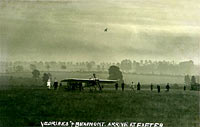 The Frenchman, Vedrines
landed first, followed by Beaumont, a spec in
the sky.
The Frenchman, Vedrines
landed first, followed by Beaumont, a spec in
the sky. 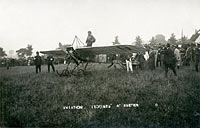 Vedrines stands in his cockpit.
Vedrines stands in his cockpit. 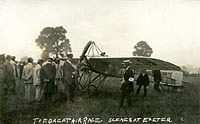 The crowd inspects Vedrines
aircraft.
The crowd inspects Vedrines
aircraft. 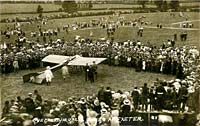 The
crowd surround Beaumont's aircraft.
The
crowd surround Beaumont's aircraft.
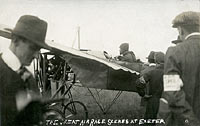 Beaumont the eventual winner
prepares or takeoff.
Beaumont the eventual winner
prepares or takeoff.
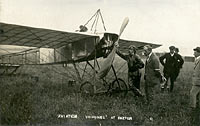 Vedrines relaxes for a few
minutes.
Vedrines relaxes for a few
minutes. 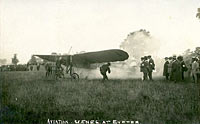 Vedrines taking off for the next
stage after 38 minutes.
Vedrines taking off for the next
stage after 38 minutes. 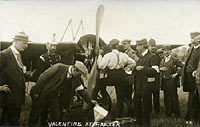 Valentine chatting to a
scrutineer.
Valentine chatting to a
scrutineer. 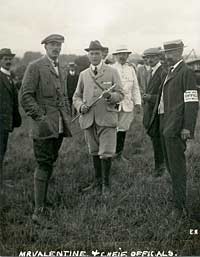 Valentine and Chief Officials
Valentine and Chief Officials 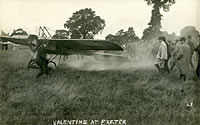 Valentine
revving for takeoff.
Valentine
revving for takeoff.
│ Top of Page │